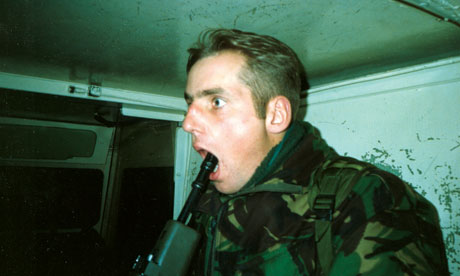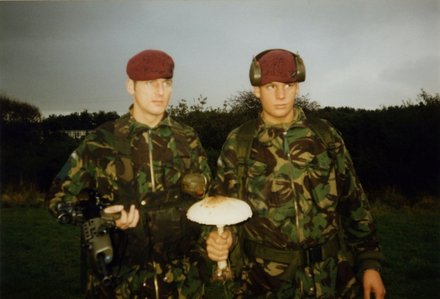
The Myth of the Airborne Warrior, published by Photoworks, is a set of personal images from the portfolio of Stuart Griffiths. As a subscriber to the Photoworks magazine I came across this work through one of their articles and was immediately struck by it.
The book contains photos taken by Griffiths during his time as a paratrooper serving in Northern Ireland. They are casual snaps of his colleges on and off duty and the streets that they patrolled in the late 80's and early 90's. To break up the images several pages include 'censored' extracts from his personal diary. The book is sold as a limited run of 500 numbered editions. Included in this version is a signed numbered 4x6 print and four facsimile documents that include a rules of engagement card and two nationalist posters.

Griffith collaborated with fellow photography student Gordon MacDonald to compile the book. The original intention was not necessarily to create a historical record of the troubles but more to help Griffith organize his images into a coherent narrative. The resulting work is an emotional record of the gradual disillusionment of Griffith. Over- trained and bound by strict rules of engagement Griffith and his colleagues found themselves in a world that was 99% boredom with 1% extreme excitement. The pictures alone do not convey this story, in fact, I feel that the images themselves are quite weak. In our current climate soldiers with their mobile phones and compact cameras are taking hundreds of photos that are similar, or better, to ones shown in this book. Griffiths' has the advantage of serving before the proliferation of war blog photos. Taken in the 80's his images already have the 'retro' style that is currently popular. Several of his images have light leaks, are too vibrant or are poorly exposed but these are strengths rather than deficiencies. The excerpts from his diary really add to the book and provide the much needed narrative. It is from these that the decline in Griffiths' morale and increasing frustrations can be felt. Much of the text has been scored through with a thick marker pen as if censored but there is enough visible behind the marker to read, albeit with a bit of effort, what is 'missing'. I like this technique as I made me feel I was breaking the rules and seeing something secret.

The book finishes with a short essay by MacDonald that charts the creative process behind the book and explains a little of the professional relationship between the two authors.

It is possible to get a look at the full book by clicking HERE. And no, those aren't my hands and painted fingernails :)
To learn more about Griffiths' work you can follow his blog HERE.
Manzine Magazine has a short but interesting interview with Griffiths HERE and Sean O'Hagan discusses the book for the Guardian newspaper HERE.

No comments:
Post a Comment